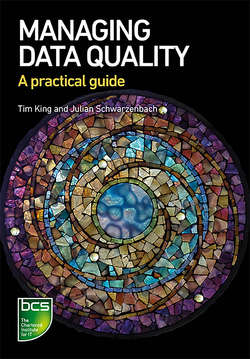Читать книгу Managing Data Quality - Tim King - Страница 8
Оглавлениеviii
Figure 1.1 The components of a business activity5
Figure 1.2 A typical life cycle for general data8
Figure 1.3 A typical life cycle for documents10
Figure 2.1 The virtuous circle of data quality16
Figure 2.2 The data triangle19
Figure 3.1 Overview of the Data Zoo29
Figure 6.1 The ISO 8000-61 process model58
Figure 7.1 Capability Level 1 of data quality management61
Figure 7.2 Capability Level 2 of data quality management63
Figure 7.3 Capability Level 3 of data quality management65
Figure 7.4 Capability Level 4 of data quality management66
Figure 7.5 Capability Level 5 of data quality management67
Figure 7.6 Overall capability model for data quality management68
Figure 8.1 The ISO 8000-61 processes by capability level70
Figure 8.2 Conceptual data model example78
Figure 8.3 Logical data model example79
Figure 8.4 The role of measurement criteria in improving data quality management87
Figure 8.5 Example Ishikawa diagram91
Table 1.1 An example data set13
Table 3.1 Comparison between real world and information world behaviours27
Table 5.1 The knowledge areas of the DAMA-DMBOK (2nd edn.)54
Table 5.2 The processes of data quality management as specified by ISO 8000-6155
Table 9.1 A maturity assessment scale for organisational data quality management95
Table 10.1 People-related improvement opportunities102
Table 10.2 Technology-related improvement opportunities102
Table 10.3 Process-related improvement opportunities103
Table 10.4 The impacts of good and bad data106
Table 11.1 Data quality management implementation considerations114
LIST OF FIGURES AND TABLES
